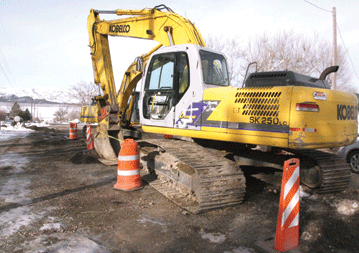
ON HOLD UNTIL WARMER WEATHER • Mona's sewer construction is on hold due to the freezing January Weather, city officials hear. The project will resume when the weather permits according to Bill Mills, Mona Mayor.
By Myrna Trauntvein
Times-News Correspondent
The freezing cold weather over the past few weeks has forced construction on the sewer lines on the Mona Sewer Collection System Construction Project to a halt.
However, work on the treatment facility will continue.
Condie Construction Company, Springville, winners of the bid to lay the sewer transmission lines, has had to stop construction.
"Due to the extreme weather," said Bill Mills, Mona Mayor, "the construction has been stopped for the rest of the month of January."
The construction crew had cleared the roads so that none were blocked and all were safe for travel, he said.
Sewer underground gravity flow pipelines begin with constructing underground trunk mains, which transport the sewage to the treatment facility. The design being used calls for the lines to be gravity powered with smaller sized laterals interconnected within a larger sized main.
Condie has been working on the trunk lines since late fall but, with the cold snap of recent weeks, has found that digging in the hard earth has been too time-consuming and difficult.
"Condie is building the underground system," he said.
They are also performing site preparation, earthwork, trench backfilling and laying of the sewer pipe. The collection system is comprised of approximately 80,000 linear feet of PVC sewer pipe and 248 precast concrete manholes. The trunk lines are being stubbed at each residence.
Pipes conveying sewage from an individual residences and other buildings to a common gravity sewer line are called laterals. Those lines will be built from a residence to the common trunk line by contractors working for individual homeowners.
The city is still working with Fosgren Associates, the Salt Lake City civil engineering firm which is acting as consultants on the project, to help obtain funding for those homeowners who fall within low-income guidelines.
Trunk sewers run under streets where they are buried in utility corridors and where they then receive laterals from buildings along that street and discharge by gravity into the treatment facility.
"Hopefully, the weather will improve in February," said Mills. "The weather has not stopped construction on the treatment site."
Work still continues on the new treatment facility known as the 0.5 mgd Membrane Bioreactor (MBR) wastewater treatment facility for sewage treatment.
"They are coming along on the site of the treatment plant," said Mills. "Work will continue there."
The system, when complete, will replace existing individual on-site wastewater treatment systems commonly known as septic systems.
The collection system is designed for the current estimated population of 1,402 and is expected to provide sufficient sewage treatment capacity for the city until the year 2030.
The Utah Water Quality Board authorized Mona City a loan in the amount of $7,350,000 repayable over 30 years at an interest rate of zero percent and a construction grant in the amount of $4,318,000. The State of Utah, Division of Water Quality (DWQ) action total wastewater project cost is $18,390,000 of which $7,213,034 is for the collection system and $11,176,966 is for the treatment system.
Additional funding was supplied by a United States Army Corps of Engineers (USACE) grant in the amount of $5,000,000.
Membrane biological reactors (MBR) combine activated sludge treatment with a membrane liquid-solid separation process.
The membrane component utilizes low pressure microfiltration or ultra filtration membranes and eliminates the need for clarification and tertiary filtration.
The Membrane Bioreactor (MBR) wastewater treatment facility will replace existing individual on-site wastewater treatment systems commonly known as septic systems throughout the community.
Groundwater table depths are shallow in and around the City of Mona and this new collection system will provide additional protection from groundwater contamination.
"We have not run into a lot of water at the treatment building site, so far," said Mills. "We are happy about that."